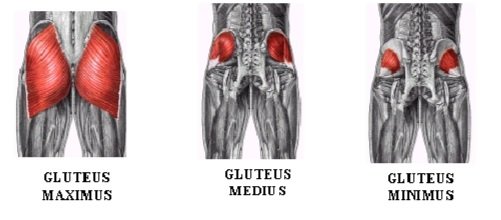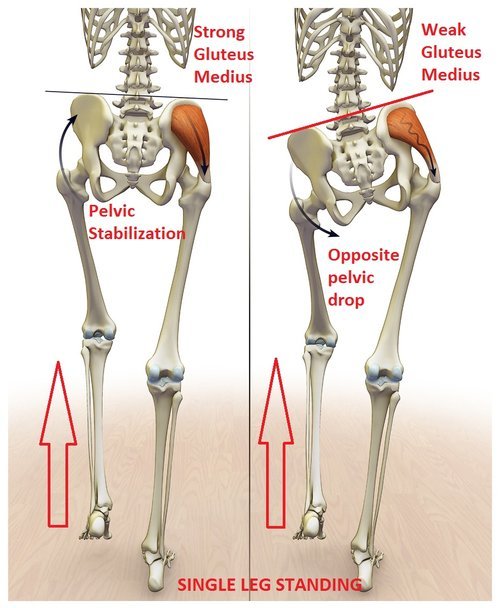Gluteus Medius
Brought to you by peakfatlossandfitness.com/glute-exercises where you can find a book I wish I had penned, Gluteus to the Maximus.
In the middle...
I'm terrible at the half-moon yoga pose. Try it for yourself. You'll quickly feel the burn. Now, keep holding it. If you're anything like me that muscle that is screaming is the gluteus medius.
Just peaking out from under the gluteus maxiumus, you just might be able to feel it flex under the part of the pelvic bone called the iliac crest. This is where the "glute med" originates, as you can see looking at the backside of anatomical models above. It inserts on the greater trochanter at the top of the femur, as you can see in the rotating model above. By pulling the greater trochanter closer to the iliac crest the leg is moved in an action called, abduction.
You can try hip abduction for yourself in a movement easier than the half-moon. Stand up with your feet together, toes pointing forward. Now shift your weight to the left leg, only lightly touching your right toes to the ground. You're already engaging your left gluteus medius so long as your hip stays level to the ground. Now take it a step further and raise your right leg to the side, and you will feel your right gluteus medius engage. As usual, with the body, your muscles are made to function in tandem, add to that the fact that many of the body's "overlooked" muscles are the stabilizers (see rotator cuff muscles of the shoulder).
Without stabilization of your hips, those impressive movements like running and jumping are just not possible. You will not be able to transfer your weight and push off the ground if your spine is flopping around. Hips and core need to stay rock solid to (just like in yoga!) in order to perform any single-leg activities. Furthermore, lots of athletic movements are side to side (lateral movement in the frontal plate), but the vast majority of what we train in the gym is only movement in the sagittal plane (i.e. front to back, think squat or deadlift).
If we are only moving our hips in the sagittal plane (flexion and extension) with squats and leg presses, then we are likely to have weak hip abductors (like the glue medius). The adductors and abductors allow you to shuffle your feet in a defensive slide in basketball. In addition, to supporting the hips in the deadlift, the abductors are the prime movers in side-to-side movements.
Which brings us to the workouts...
I suppose you could be like this fellow to the right and perform some hip abduction with a cable machine, but I think the exercise band wrapped around the knees is more versatile. Start with performing squats with the band around your knees while you resist adduction. This could also be used in your warm up before doing squats and will help you keep good form.
Isolating movements with the band include the aptly named fire hydrant and clam shell exercises seen above. I think you can figure out which is which. Of course, as mentioned at the top, many yoga poses with the hips perpendicular to the ground, like half moon, include resisted hip abduction.
Also, check out Chad Waterbury's Build Your Glutes Fast! page for exercises and for even more nerdy stuff, read his Glute Training Science page to get some EMG data, etc.
What I would most recommend for the athlete, is adding the band around the knees for many of your sport's specific movements. This might mean defensive slides in basketball or cross-court shuffle in tennis. If you can perform these well with the band, you will feel the difference in games without it.











